December 2007 // Volume 45 // Number 6 // Commentary // 6COM1
True Colors Shining Through: Cooperative Extension Strengths in Time of Disaster
Abstract
Responding to the destruction brought to Louisiana by hurricanes Katrina and Rita proved extraordinarily challenging for the Louisiana Cooperative Extension Service (LCES). Responding to and recovering from such widespread destruction also provided valuable insights into the vital services that state Cooperative Extension Services have the capability to provide. In this Commentary, we share just a few of the insights we gained from surviving these disasters and provide some "lessons learned" that we hope you will find valuable as you consider the essential roles you play in your communities.
Hurricane Katrina was one of the worst natural disasters in U. S. history (CNN, 2005). The combined impact of Hurricanes Katrina and Rita on Louisiana was overwhelming, and, 2 years after, there are hurricane-related problems in our state that are still unresolved. No organization, including the Louisiana Cooperative Extension Service (LCES), was prepared for the loss of life, homes, offices (Figure 1), jobs, and resources that the hurricanes produced. However, it is in the nature of the Extension Service from its earliest days to respond to such emergencies (Williamson, 1940). Furthermore, hurricanes Katrina and Rita left indelible marks on the LCES, teaching us about ourselves and our strengths, and leaving us with valuable lessons for the future.
Figure 1.
Cameron Parish Extension Office
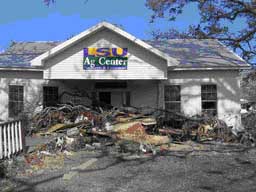
A Major Organizational Strength--Our People
An organization is only as strong as its people. Responding to and recovering from these disasters showed the "true colors" of LCES--the dedication and sincerity our staff. With a mandatory evacuation of the New Orleans area, power outages and downed cell phone towers throughout the region, and news reports of injuries, fatalities, and human desperation, the first concern after Katrina hit was our people and their safety. It took over a week to account for everyone who worked for LCES. At one time, 14 parish offices were closed due to the storms.
Emergency leave was granted for up to a month to give people time to find shelter, stabilize their families, and, in some cases, get settled into new LCES offices. Those who could, returned to work; those who could not, used the time to restore their personal lives, property, and family. Without this acknowledgement of the individual struggles of some of our employees, the organization may have lost valuable employees to stress-related illnesses. Employees became the top priority for administrators.
Even though state LCES offices in Baton Rouge were closed for a week following Katrina, Extension personnel were at work immediately. A few examples of heroic efforts on the part of our staff follow.
- The Extension Disaster Education Network (EDEN) coordinator for Louisiana was part of disaster response personnel at the state Emergency Operations Center. She served as liaison between LCES and other agencies in coordinating collaborative efforts. Working 16-20 hour days was the norm for her the 2 weeks following Katrina.
- A coastal fisheries agent returned from evacuation immediately following Katrina to help commercial fishermen find their boats, many of which had floated from their moorings and ended up on dry land, sometimes miles from where they were docked (Figure 2).
Figure 2.
Boat Recovery Efforts
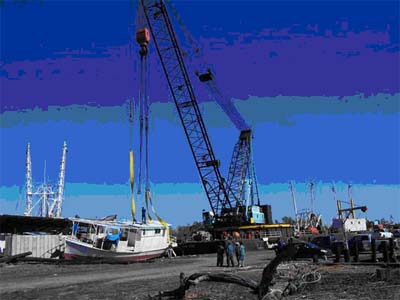
- An Orleans Parish agent, who evacuated to the Baton Rouge area, was temporarily reassigned to the state office following Katrina and became the chair of the Extension Family and Consumer Sciences Hurricane Response Task Force. She worked diligently with several recovery groups representing LCES programs for families and coordinated massive distribution of family-related recovery publications (Figure 3).
Figure 3.
Distribution of Family Recovery
Information

- In both storms, tens of thousands of cattle were stranded or drowned due to the storm surge (Figure 4). Our faculty, many with lost or severely damaged homes themselves, immediately returned and assisted in rescuing cattle in a massive multi-week effort to help Louisiana cattlemen. Extension coordinated hay and feed donations, often working 16-18 hour days during the height of the response (Figure 4).
Figure 4.
Recovering Stranded Cattle
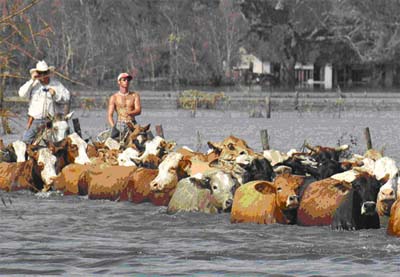
Despite experiencing tremendous personal loss and facing a very uncertain future, many Extension professionals reached out to serve fellow Louisianans. Across Louisiana, all Extension staff worked to address critical needs--at shelters (Figure 5), disaster recovery centers, schools, and other locations (Figure 6). The "true colors" of Extension's people and their culture of service came "shining through" during this trying time.
Figure 5.
Agents Conducting Activities
with Youth at Shelter
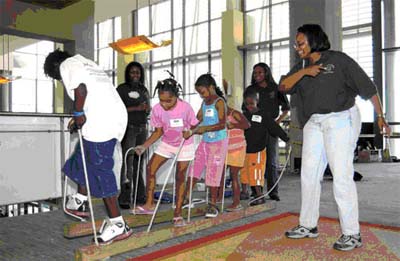
Figure 6.
4-H Youth Organizing Donations
for Children
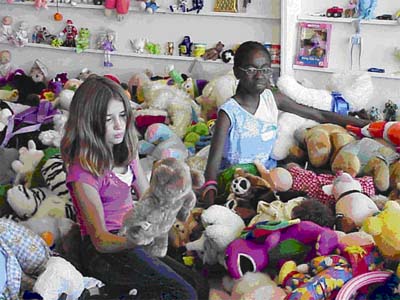
A Second Organizational Strength--Our Extension Model
An effective organizational structure encourages competent people to achieve excellence in their work (Quinn & Spreitzer, 1997). Our Extension model proved successful in enabling a significant LCES response to the devastation following the hurricanes, which previous experience and research has shown to be tremendous (Bates, Fogleman, Parenton, Pittman, & Tracy, 1963). The cooperative model, featuring broad partnerships, focusing on assessing human and community needs, and providing research-based solutions to problems, empowered LCES staff to respond to the hurricanes in effective ways.
A major organizational strength and asset in the LCES disaster response was our statewide network of Extension offices in every parish. Trusted Extension educators were able to immediately help families, farmers, fishermen, community leaders, teachers, and youth deal with tragedy, respond to needs, and begin long-term recovery efforts that continue today. Our national Extension system allowed for instantaneous sharing of pertinent information through the Extension Disaster Education Network (EDEN) and other states that experienced hurricane impacts (e.g., North Carolina, Florida, and Mississippi).
Another feature of the Cooperative Extension Service model that served us well was our service design to identify human and community needs, get local input on potential solutions and strategies, present university knowledge that can help improve lives, and help citizens and communities implement best practices that effectively address challenges. Extension is a trusted information source in communities and provided disaster information to hundreds of thousands of Louisianans.
For example, our Extension specialists (including campus communications and information technology) responded immediately to the needs identified by the agents in their quest to help communities. This included recovery information provided through intense media and technological outreach efforts (radio, television, newspaper articles, internet fact sheets, and a telephone hotline) that are critical to an effective educational response (Figure 7).
Figure 7.
Extension Faculty Providing
Information via Hurricane Hotline

In addition our do-it-yourself recovery information for homeowners about housing (mildew and mold removal, furniture restoration, air quality, and home mitigation information), safety, trailer living, and landscape/yard restoration (landscape debris removal, etc.) was printed in large quantities and distributed by Extension staff following Katrina and Rita (Figure 8). Coping with stress information from our 9/11 recovery materials was quickly adapted and made available to families to help them cope more effectively and support their children during a very emotional time. One of our "true colors," the knowledge available from our land-grant institutions through Cooperative Extension Services, proved extremely valuable in dealing with these disasters.
Figure 8.
Storm Recovery Publication
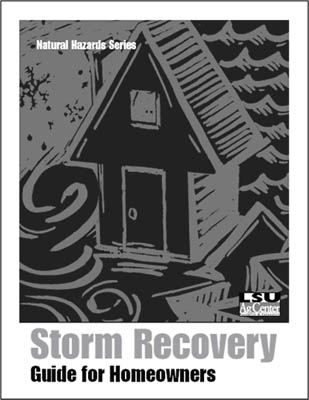
Yet another feature of our Extension model that contributed to the effectiveness of LCES's hurricane response was our work in collaboration with many local and state agencies, organizations, and entities. Our past relationships with these groups allowed Extension to provide a multi-layered, multi-faceted response addressing critical human and community needs during desperate times. Additionally, agents and campus specialists established new connections with unfamiliar groups and leaders that allowed LCES to accomplish more for Louisianans.
Extension's mission--to provide research-based, relevant information to improve lives--works well in times of tranquility and disaster. In a disaster, the reaction and implementation time is much faster, and agents must make decisions often without assurances that normally exist. Following the hurricanes, after personnel made sure their families were secure and safe, Extension administration empowered agents to quickly re-enter the disaster zone and, with autonomy, begin implementing response and recovery efforts. Facing a disaster of this magnitude taught us invaluable lessons that could help other Extension services when facing disasters.
Lessons Learned from Katrina and Rita
- Have a plan to account for personnel in times of disaster.
- Be prepared to print publications (or have inventory) that can meet immediate needs post-disaster.
- Be prepared to lose communication technology: have contingency plans, use satellite phone technology, and bring in mobile Internet connectivity that can run on generated power.
- Have emergency fuel stocks in place for travel and portable generator power needed to re-establish connectivity in disaster areas.
- Have a list of emergency contact information available for all personnel.
- Have an emergency housing and business re-establishment plan.
- Be prepared to set up emergency livestock rescue operations.
- Be prepared to deal with animal carcass disposal.
- Be prepared to deal with rescued companion animals (primarily cats and dogs) following a flood event.
- Have a pre-established volunteer management plan in place.
- Have in place a plan to accept, manage, and fairly allocate donations.
- Be prepared to put in place a system for accepting and fairly allocating internal organizational financial donations.
- Be patient, and be prepared to take risks and empower employees to get the job done on the ground with minimal interference--but with willingness and offer to help in any way necessary.
- Collaborate with other entities for disaster management, considering how the organizations should work together for maximum assistance.
- Recognize that disasters can provide a valuable "teachable moment." Providing information to people in crisis can help them learn and move forward as they pick up the pieces.
Conclusions
Louisiana is still recovering from the devastation of the 2005 hurricane season. Louisiana people and organizations, including LCES, are forever changed as a result. We have learned a great deal about what we are made of in the process; we have learned our "true colors." LCES provided Louisianans and communities with critical information about very tough subjects and did it in a way that moved communities forward.
In a time of disaster, state Extension Services have the opportunity to be a local beacon of recovery while working side-by-side with others in the community. Serving in this way has helped our Extension Service grow stronger. We know our "true colors" and they are "shining through" for our citizens and communities. We challenge your organization to consider your disaster preparedness as well as the vital role you play helping communities in both times of prosperity and in times of disaster. Is your Extension Service ready?
References
Bates, F. L., Fogleman, C. W., Parenton, V. J., Pittman, R. H., & Tracy, G. S. (1963). The social and psychological consequences of a natural disaster: A longitudinal study of hurricane Audrey. Washington, D.C.: National Academy of Sciences — National Research Council.
CNN (2005). New Orleans evacuations underway: Health emergency declared; thousands may be dead. Cable News Network. Retrieved November 8, 2007 from http://www.cnn.com/2005/WEATHER/08/31/katrina.impact/index.html
Quinn, R. E. & Spreitzer, G. M. (1997). The road to empowerment: Seven questions every leader should consider. Organizational Dynamics, 26, 37-49.
Williamson, F. W. (1940). How twenty-five years of Extension Service changed the pattern of farming and rural life. Yesterday and Today in Louisiana Agriculture. Baton Rouge, LA: Louisiana State University and Agricultural and Mechanical College, Division of Agricultural Extension.
